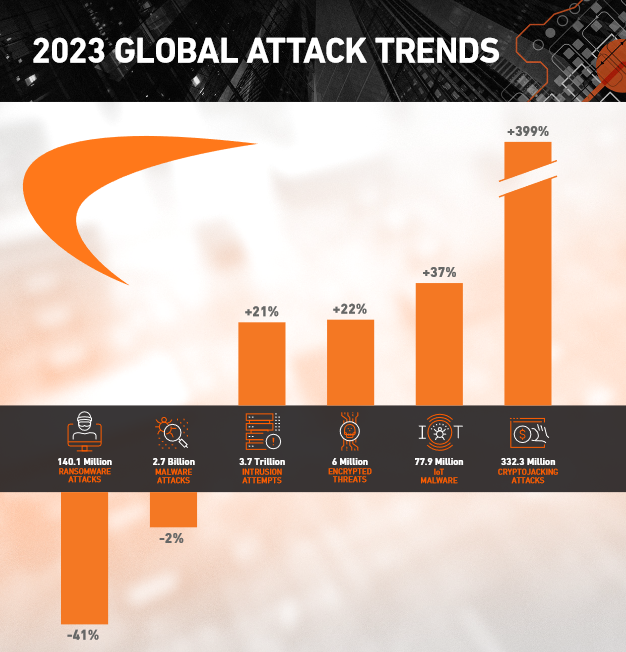As technology becomes more advanced, the threat landscape in cyberspace continues to evolve. Cybercriminals are constantly finding new ways to exploit vulnerabilities and infiltrate systems for their own gain. One such growing trend in cyberattacks is cryptojacking. In this mid-year update of the 2023 SonicWall Cyber Threat Report, we delve into the record surge of cryptojacking incidents and its global implications.
What is Cryptojacking?
Cryptojacking involves the unauthorized use of a victim’s computer or device to mine a cryptocurrency. Unlike traditional ransomware attacks where criminals hold data hostage in exchange for payment, cryptojacking is a covert operation that often goes unnoticed. Cybercriminals rely on compromised websites, malicious email attachments, or even infected ads to deliver malware onto unsuspecting victims’ systems.
The Rise of Cryptojacking
Cryptojacking has seen a drastic surge in recent years, with 2023 being no exception. This trend can partially be attributed to the increasing popularity and value of cryptocurrencies. As the demand for cryptocurrencies rises, cybercriminals are finding more lucrative incentives to mine these digital assets without investing in the necessary hardware and energy costs.
Furthermore, the rise of advanced hacking techniques, such as fileless malware and encrypted traffic, has made it easier for cybercriminals to evade detection by traditional security measures. This allows them to hijack systems and utilize their computing power for cryptocurrency mining, all while remaining under the radar.
In 2022, cryptojacking surpassed 100 million for the first time ever. In the first six months of 2023, attack volumes have not only eclipsed that milestone, they’ve more than tripled it, rising 399% to more than 332 million hits — compared to just 66.7 million during the first half of last year.
The Global Impact
Cryptojacking has become a global phenomenon, affecting individuals, businesses, and even entire nations. No industry or sector is immune to this threat. From small businesses to multinational corporations, cryptojacking can lead to significant financial losses and operational disruptions.
In addition to financial implications, cryptojacking can also compromise sensitive customer data, leading to potential legal liabilities and reputational damage. The loss of customer trust can have long-lasting effects on businesses, impacting their bottom line and their ability to attract new customers.
Protecting Against Cryptojacking
Given the pervasive nature of cryptojacking, organizations must take proactive steps to protect themselves from this growing threat. Implementing a multilayered defense strategy is crucial to mitigating the risk of cryptojacking attacks. Here are some key measures businesses should consider:
1. Regularly update and patch systems: Keeping software and operating systems up to date is essential to address any known vulnerabilities that cybercriminals exploit.
2. Educate employees: Training employees on how to identify and report suspicious emails, links, and attachments can help prevent malware from infiltrating the organization’s network.
3. Use reliable antivirus software: Deploying robust antivirus software can detect and block cryptojacking malware, providing real-time protection against these threats.
4. Monitor network traffic: By closely monitoring network traffic and analysing patterns, organizations can identify any unusual spikes in CPU usage that may indicate cryptojacking activities.
5. Consider browser extensions and ad-blockers: Implementing browser extensions and ad-blockers can prevent malicious cryptocurrency mining scripts from executing, reducing the risk of cryptojacking.
22 | Mid-Year Update: 2023 SonicWall Cyber Threat Report | Cryptojacking
Cryptojacking by Industry
The number of cryptojacking hits rose across every industry we studied — and many of these jumps were massive. Given the very small number of cryptojacking hits, several of these industries saw over the first half of 2022, as well as the speed, with which these totals are growing, it makes more sense to speak about these changes in terms of factor increases versus percentage increases.
The number of cryptojacking hits targeting those in retail more than doubled in the first half of 2023, and the average percentage of customers targeted each month rose from .06% to .30%. Finance customers saw 4.7 times the number of cryptojacking attempts in the first six months of 2023, and the percentage of customers targeted rose from .05% to .36%.
Customers working in healthcare were targeted by 69 times more cryptojacking than in 1H 2023, and the percentage of customers affected jumped from .06% to .32%. Government customers saw 89 times the amount of cryptojacking, with 0.37% targeted per month on average. But it was education that saw the biggest jump: the number of cryptojacking hits recorded by education customers increased 320 times year-to-date, and the average percentage of customers targeted each month rose from 0.19% to 0.55%.
Conclusion
Cryptojacking continues to be a significant global cyber threat, with cybercriminals capitalizing on the increasing popularity of cryptocurrencies. It is essential for organizations, both large and small, to remain vigilant and take proactive steps to protect their systems and networks from this evolving threat. By implementing strong security measures, businesses can safeguard their data, finances, and reputation, ensuring a safe digital environment for themselves and their customers.



